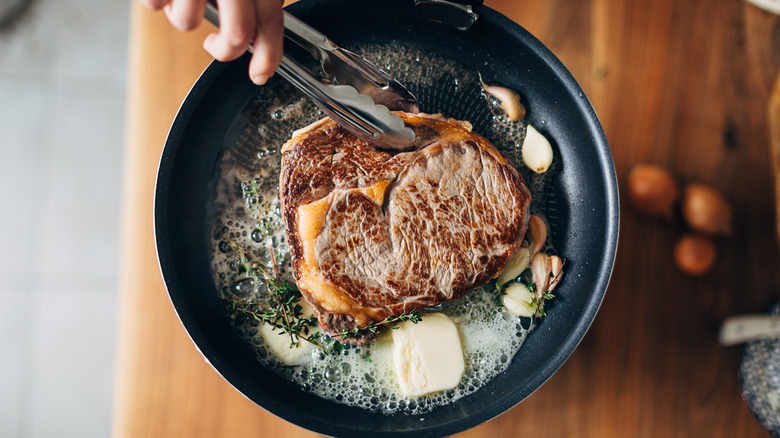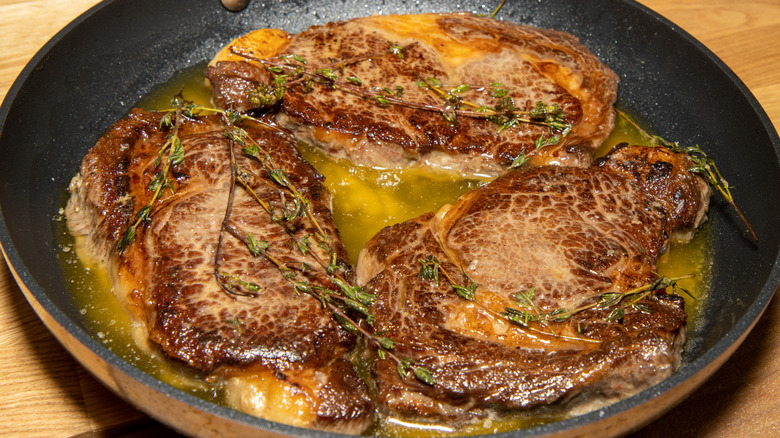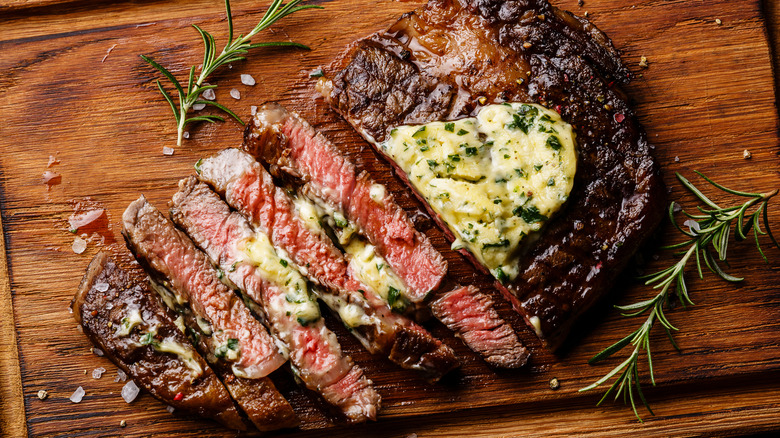Slowly Cook Steak In A Butter Bath For A Decadent Meal
It's hard to think of any two foods that have been more vilified over the last 50 years than red meat and butter. Through numerous fat-free crazes to our current fixation on plant-based meats, beef and butter have endured nevertheless. And as current research shows that beef and butter may not be the harbingers of an early grave we were all led to believe, we have no qualms about encouraging you to slow-cook your steak in a cauldron of melted butter.
Your eyes are not playing tricks on you. You did, in fact, just read the words "cauldron of melted butter." While this may seem decadent to the point of extreme — and, in some ways, it absolutely is — steak and butter have always worked well together. Slather some seasoned compound butter onto a perfectly cooked steak and, for the unapologetic carnivore, you've got yourself a ticket to steak nirvana.
There isn't one way to cook a steak properly — searing, reverse searing, broiling, and grilling, are all perfectly acceptable ways of getting that tender meat with a great crust. So, if you're willing to be patient, and can get over the initial shock of submerging a giant piece of meat in what seems an unholy amount of butter, there is a reward in it for you at the end.
A buttery sous vide
It's important to approach this method of cooking steak differently than the way you're likely used to. You won't start by searing it with high heat and then finishing it off in the oven. Instead, the key to success with this method is to understand it as a sort of buttery braise meets sous vide.
A classic sous vide involves sealing the meat in plastic and submerging the package in water at a consistent, low temperature that slowly cooks the meat inside. For this recipe you want to forgo the plastic bag and submerge the meat directly in the melted butter, making it more of a braise. However, you want to be sure to keep the butter at a consistently low temperature. You do not want it to froth or simmer, because the butter will burn if it gets too hot. Keeping the butter at a consistent, low temperature, no higher than 122 degrees Fahrenheit, will be just warm enough to slowly cook the meat. It should take about 40 to 50 minutes or until the steak reaches an internal temperature of 120 degrees.
At this point, the steaks will look gray and not remotely attractive. So it's at this point that a good sear is necessary in order to develop a nice crust. Over high heat, or under a screaming broiler, sear the outside of the meat for about 45 seconds to one minute. Season with salt and pepper and allow the meat to rest before slicing into it.
What does butter bath steak taste like?
Anyone who has cooked with butter knows, it has a savory, mildly sweet, fatty elevation that it brings to any dish. Slowly cooking the steak in butter allows the time necessary for the butter and steak fats to become soluble, and for flavors to intermingle. You needn't just cook with plain butter. You can add extra flavors, such as rosemary and garlic for an extremely tender steak inoculated with the flavored butter.
There is the potential for the butter to overpower the flavor of the steak itself. However, that's a matter of taste preference more than anything else. One thing you could do, if you want to strike a balance between butter and steak, is to copy chef Tyler Florence. Once Florence is finished cooking his steaks, he allows them to rest in a bath of clarified butter. During this rest, the steak relaxes and releases all of its wonderful juices into the butter. The butter, in turn, is flavored and all of that liquid gets reabsorbed into the steak, making it even juicier.
As you've no doubt realized, this is not a cheap cooking method. To cook with this amount of butter (upwards of two pounds) plus the recommended T-Bone or ribeye steaks is going to be expensive. However, your reward is the enjoyment of a delicious steak that's buttery, tender, and bursting with fantastic meat, dairy, and herb flavors. It's worth the special expense.


